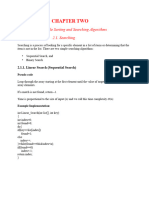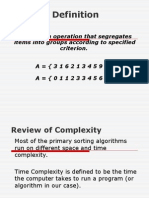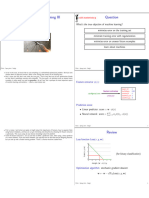0% found this document useful (0 votes)
6 views19 pagesBook Chapter 03 - Simple Sorting Algorithms
This document discusses simple sorting algorithms, specifically bubble sort, selection sort, and insertion sort, highlighting their mechanisms and performance. All three algorithms have a time complexity of O(N^2), with insertion sort generally being the fastest for small arrays. The document also emphasizes the importance of understanding loop invariants and mentions that certain algorithms can perform better on nearly sorted arrays.
Uploaded by
lihit19426Copyright
© © All Rights Reserved
We take content rights seriously. If you suspect this is your content, claim it here.
Available Formats
Download as PPTX, PDF, TXT or read online on Scribd
0% found this document useful (0 votes)
6 views19 pagesBook Chapter 03 - Simple Sorting Algorithms
This document discusses simple sorting algorithms, specifically bubble sort, selection sort, and insertion sort, highlighting their mechanisms and performance. All three algorithms have a time complexity of O(N^2), with insertion sort generally being the fastest for small arrays. The document also emphasizes the importance of understanding loop invariants and mentions that certain algorithms can perform better on nearly sorted arrays.
Uploaded by
lihit19426Copyright
© © All Rights Reserved
We take content rights seriously. If you suspect this is your content, claim it here.
Available Formats
Download as PPTX, PDF, TXT or read online on Scribd
/ 19























































































